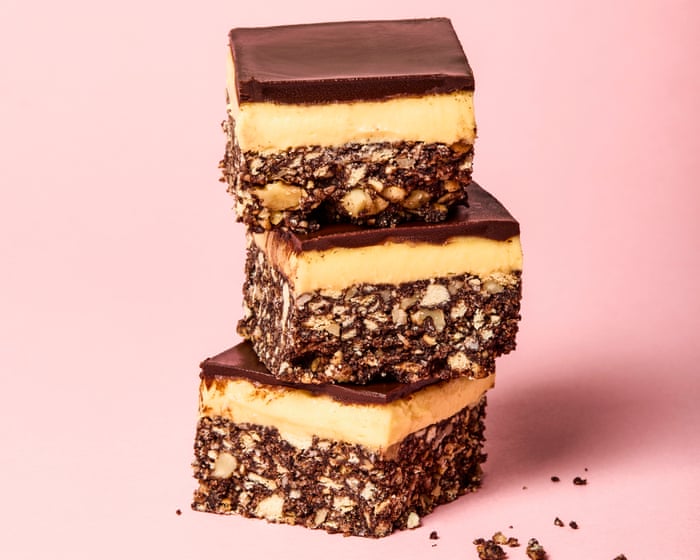Canadians are famously polite—think of laid-back Keanu Reeves, cheerful Pamela Anderson, or the charmingly clumsy Inspector Gadget—but there’s one thing that can test their patience: the Nanaimo bar. Mess up the ratio of this three-layered national treasure, as the New York Times did in 2021 when its Instagram posted a photo that one user called “an insult to Canadians everywhere,” and you’ll quickly learn just how far you can push them.
The Times isn’t alone in facing backlash. Nanaimo bars (pronounced nuh-NYE-mo), named after the British Columbia town where they originated, are so beloved that Canada Post featured them on a stamp in 2019. That also drew outrage, though expressed in classic Canadian style. The mayor of Nanaimo politely noted, “One hesitates to be critical, but it’s not a very accurate depiction.”
In short, Canadians take these sweet treats very seriously. Voted the nation’s favorite confection in 2006, Nanaimo bars are a staple at everything from kids’ birthday parties to wedding buffets and funeral gatherings across the country. Even when served at a state dinner with Barack Obama in 2016, Prime Minister Justin Trudeau was too polite to complain if the White House version wasn’t quite right. Feel free to share your thoughts in the comments—I’m British, I can handle it.
The Base
Before trying a Nanaimo bar, I assumed the base—made mainly of biscuit and coconut—would be crunchy, like a cheesecake crust. I was wrong. Except for the Canadian Living recipe, which bakes it briefly to dry it out, the base sets in the fridge rather than the oven.
Another surprise: instead of large biscuit chunks in chocolate, as you might find in a British fridge cake, the base is made of fine crumbs soaked in sweet, cocoa-flavored butter, giving it a soft, almost squidgy texture. Once I got used to that (I do love a crunchy base), I had to find the best substitute for graham cracker crumbs, which Canadian recipes call for.
Graham crackers (pronounced “gram”) are a North American specialty, named after Sylvester Graham, a 19th-century preacher and health advocate who warned against refined sugars and grains. His original crackers were unsweetened and made with coarse whole wheat. Modern versions, often sweetened and flavored, would probably shock him. They’re also expensive online—around £18 a box before shipping—so I skipped those but bought some crumbs to compare.
The crumbs turned out to be a fine, slightly gritty powder, tasting somewhere between a digestive and a rich tea biscuit. Since texture isn’t crucial here, I tested rich tea, digestives, and Hobnobs (a suggestion from UK baker Cupcake Jemma) and found you can use whichever you prefer. I liked the milder sweetness of rich tea, but you might prefer the oatiness of Hobnobs or the malty flavor of digestives. I left a few larger chunks in my version for extra texture.This might offend Nanaimo purists—if so, feel free to skip ahead.
I’ve tried making my own graham crackers using a recipe from Deb at Smitten Kitchen, but they always turn out sticky and chewy—probably due to metric conversions—and are hard to grind. They taste good, but I find they just add an extra step. The Nanaimo bar was meant to use processed ingredients, and I’m happy to stick with that tradition.
Susan Mendelson’s Nanaimo bars have the most popular base. The biscuit layer includes coconut, a classic British Columbian ingredient. Zingerman’s Bakehouse recommends fresh coconut, while Susan Mendelson (whose recipe Margaret Atwood included in her 1987 Canlit Foodbook) uses unsweetened shredded coconut. Serious Eats and Canadian Living suggest the sweeter, moister kind. Since sweetened coconut isn’t easy to find in the UK, Nigella.com suggests mixing sugar and hot water into desiccated coconut as a substitute. Fresh coconut makes the base too wet—almost like trifle—and sweetened coconut just adds more sugar, so plain desiccated coconut feels like the best and easiest option.
Nuts are also key. Margaret Atwood prefers walnuts, while Joyce Hardcastle—whose recipe won a Nanaimo contest in 1986—uses finely chopped almonds. Susan Mendelson offers a choice of walnuts, almonds, pecans, or a mix. Personally, I like the bitterness of walnuts, which complements the cocoa and balances the sweetness of the other layers. Toasting the nuts, as Zingerman’s suggests, really brings out their flavor—and you might as well toast the coconut, too.
For the base, the crumbs, coconut, and nuts are held together by a ganache-like mixture of melted butter, sugar, egg, and cocoa powder. Mendelson’s recipe, featured in the New York Times, uses the least butter and sugar relative to nuts and crumbs, though I like to add a bit more cocoa to enhance the bitter notes. There’s no need to bake the base—it just makes it crumbly and hard to cut.
At the risk of upsetting Canadians—I really want to visit someday, so this is risky—the base should be thicker than the custard or chocolate layers. Those are really just icings, adding extra sweetness and fat. Too much of a good thing is still too much, unless you’re working outside in freezing temperatures all day. Then it’s justified.
Now, about the custard layer: it’s not actually custard—it’s custard-flavored buttercream. In my opinion (and my testers agree), this is why Nanaimo bars are often called “tremendously sweet” (even by American standards). Most recipes use an 8:1 ratio of powdered sugar to butter. For comparison, Mary Berry’s buttercream uses a 2:1 ratio. Only Joyce Hardcastle and Molly Allen (Serious Eats) suggest a more moderate 4:1 ratio. I’ve reduced the sugar even further to suit my taste—feel free to adjust as you go. Less sugar also makes the texture lighter, especially if you use milk instead of heavy cream to thin it, as those two recipes recommend.
Just a note: Joyce Hardcastle specifies finely chopped almonds in her Nanaimo bars, so keep that in mind.Almost every recipe I try, except for those from Canadian Living, calls for unsalted butter. Hardcastle even insists on “European-style cultured” butter, which is fermented before churning to give it a tangier, more complex flavor. I have no hesitation in saying this is a complete waste of money, because once the butter is mixed with sugar, no one can taste the difference. Only Allen recommends adding salt to balance the sweetness—personally, I just use salted butter to begin with, not least because that’s what I always have on hand. However you include it, salt is essential.
What makes Nanaimo bars unusual is the use of custard powder for flavoring; traditionally, Bird’s is the go-to, which suits me just fine. American recipes often suggest vanilla pudding mix as a substitute, but for once, I already have the right thing on my shelf. As a fan of cornflour custard, I recommend dissolving the custard powder and some sugar in milk before mixing it in, to avoid the slightly powdery texture that often plagues these bars.
Allen and Canadian Living are also unusual in using vanilla extract to enhance the custard powder’s flavor. For me, part of Bird’s charm is its nostalgic artificial vanilla taste, but if you avoid ultra-processed foods, feel free to use cornflour and real vanilla extract instead. Otherwise, I see no reason to complicate things with the real, highly perfumed version.
As for the chocolate, chocolate is chocolate—I find 70% cocoa with butter makes a fine topping. You could experiment with additions like orange zest or the New York Times’ suggestion of sea salt, though I don’t think the classic combination of nutmeg and custard can be improved upon.
The most important lesson I learned in making these is patience. Chill each layer thoroughly before adding the next, and everything will be much easier—a detail many recipes I tried conveniently left out. (If you’re Canadian, you probably just know this instinctively.) The crumb base needs to be firm enough to spread the buttercream on top, and the buttercream should be set enough to handle the warm chocolate without melting. Oh, and line your pan, unless you want to end up with scratches.
As Allen notes, Nanaimo bars are best served cold from the fridge, not at room temperature, despite what some recipes claim. She allows that you can let them sit out for a few minutes if you prefer, but be prepared for very soft chocolate and custard layers. Maybe my fridge is set to Canadian room temperature—who knows?
Perfect Nanaimo Bars
Prep: 40 min
Chill: 2 hr+
Makes about 16
For the base:
75g shelled walnuts, or nuts of your choice
75g desiccated coconut
225g plain biscuits (I use rich tea)
100g butter, cubed (I use salted)
50g sugar
30g cocoa powder
A pinch of salt
1 egg, beaten
For the custard layer:
80g soft room-temperature butter (I use salted)
160g icing sugar, sifted
3 tbsp custard powder
2 tbsp milk
A pinch of salt
For the topping:
120g 70% cocoa chocolate
2 tbsp butter
Freshly grated nutmeg, to taste (optional)
Heat the walnuts in a dry pan over medium heat, shaking occasionally, until fragrant. Remove and let cool slightly. In the same pan, toast the coconut until golden apricot in color, then remove. Use a food processor (or a rolling pin and plastic bag) to crush the biscuits into uneven crumbs—a few larger pieces are fine. Roughly grind the nuts, again leaving some chunks, and be careful not to overprocess them into butter.
Put the butter and sugar in a heatproof bowl set over a pan of simmering water. Heat…Stir occasionally until the butter has melted. Meanwhile, place the biscuit crumbs, nuts, and coconut in a large bowl. Line a roughly 20cm x 20cm baking tin with baking paper—crumple it first to help it fit into the corners and sides.
Mix the cocoa and a pinch of salt into the butter and sugar, then add the egg and stir until the mixture thickens slightly (you may need to whisk it). Remove from the heat, combine with the biscuit, nut, and coconut mixture, and once everything is coated, transfer it to the lined tin. Press it down firmly into an even, flat layer. Cover and freeze for 10 minutes (or refrigerate for 30 minutes) until firm.
For the custard layer, place the butter in a large bowl or stand mixer and beat until soft. Sift in the icing sugar and beat until the mixture is light and fluffy. In a small bowl, stir the custard powder and milk until the powder dissolves, then beat this into the butter mixture along with a pinch of salt, if using. Spread this over the chilled biscuit base, being careful not to mix in too many crumbs. Cover and chill again for at least an hour, until firm.
Melt the chocolate and butter in a heatproof bowl set over a pan of simmering water, and grate in the nutmeg if desired. Remove from the heat, let it cool slightly, then pour it over the custard layer. Tilt the tin to spread the chocolate evenly. Tap the tin on the counter to settle the chocolate, then cover and return to the fridge. After about 20 minutes, once the chocolate has started to set but is still slightly soft, score it into bars or squares. Return to the fridge to set completely.
To cut, lift the slab out of the tin using the paper lining. For cleaner slices, dip a knife in hot water, wipe it dry, and then cut. Store the Nanaimo bars covered in the fridge for up to five days, or wrap and freeze them.
Nanaimo bars: a Canadian classic, or do they fall short compared to poutine and butter tarts? If you’re a fan, share what makes a great Nanaimo bar and your thoughts on modern variations.
Frequently Asked Questions
Of course Here is a list of helpful FAQs about making perfect Nanaimo bars based on Felicity Cloakes guide
FAQs Making Perfect Nanaimo Bars
Q What exactly is a Nanaimo bar
A Its a famous Canadian nobake dessert with three distinct layers a crumbly chocolatecoconut base a rich custard buttercream middle and a thin chocolate ganache top
Q Do I need any special equipment to make them
A Not really A standard 8×8 inch baking pan a saucepan for the base a mixing bowl for the middle layer and a whisk or electric mixer are all you need
Q My base layer is too crumbly and falls apart What did I do wrong
A You likely didnt press it into the pan firmly enough Use the bottom of a measuring cup or a glass to really compact it down before chilling
Q Can I use something other than custard powder for the middle layer
A Yes but it will change the classic flavor Instant vanilla pudding powder is the most common substitute though the taste will be slightly different
Q My middle layer is too runny How can I fix it
A This usually happens if the butter was too soft Make sure your butter is just softened not melted Pop the whole pan back in the fridge to let the layer firm up before adding the chocolate top
Q The chocolate topping cracked when I cut the bars How do I prevent that
A Let the bars sit at room temperature for 1015 minutes before slicing Using a sharp knife dipped in hot water will also help you cut through the hard chocolate cleanly
Q Can I make Nanaimo bars ahead of time
A Absolutely They are perfect for making ahead They keep very well in an airtight container in the refrigerator for up to a week or you can freeze them for a couple of months
Q Are there any common variations on the classic recipe
A Definitely People often make mint Nanaimo bars by adding peppermint extract to the middle layer or peanut butter bars by adding peanut butter to the base or middle




